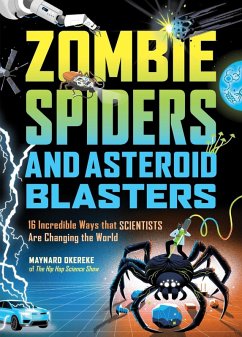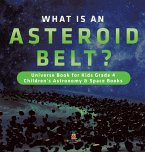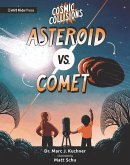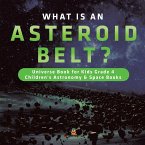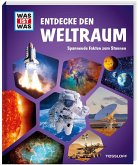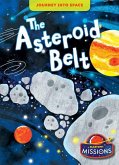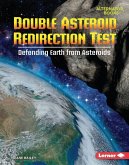Maynard Okereke
Zombie Spiders and Asteroid Blasters
16 Incredible Ways That Scientists Are Changing the World
Versandkostenfrei innerhalb Deutschlands
14,99 €
inkl. MwSt.
Versandkostenfrei*
Erscheint vorauss. 3. März 2026
Melden Sie sich
hier
hier
für den Produktalarm an, um über die Verfügbarkeit des Produkts informiert zu werden.

7 °P sammeln
Maynard Okereke
Zombie Spiders and Asteroid Blasters
16 Incredible Ways That Scientists Are Changing the World
- Gebundenes Buch
Have you ever heard of a spider being turned into a useful robot? Or a real-life planetary defense team protecting the Earth from asteroids? Sounds like science fiction…but it’s not! Take a wild ride with Maynard Okereke, the Hip Hop MD, into some of the most fascinating and strange corners of scientific research, from physics and engineering to ecology and neuroscience. These wacky wonders of nature and technology will wow all readers and inspire budding scientists to look at the world with fresh curiosity and consider how science can be used to help people, help nature, or enhance our…mehr
Andere Kunden interessierten sich auch für
![What is an Asteroid Belt? Universe Book for Kids Grade 4 Children's Astronomy & Space Books What is an Asteroid Belt? Universe Book for Kids Grade 4 Children's Astronomy & Space Books]() BabyWhat is an Asteroid Belt? Universe Book for Kids Grade 4 Children's Astronomy & Space Books27,99 €
BabyWhat is an Asteroid Belt? Universe Book for Kids Grade 4 Children's Astronomy & Space Books27,99 €![Cosmic Collisions: Asteroid vs. Comet Cosmic Collisions: Asteroid vs. Comet]() Marc J KuchnerCosmic Collisions: Asteroid vs. Comet14,99 €
Marc J KuchnerCosmic Collisions: Asteroid vs. Comet14,99 €![What is an Asteroid Belt? Universe Book for Kids Grade 4 Children's Astronomy & Space Books What is an Asteroid Belt? Universe Book for Kids Grade 4 Children's Astronomy & Space Books]() BabyWhat is an Asteroid Belt? Universe Book for Kids Grade 4 Children's Astronomy & Space Books20,99 €
BabyWhat is an Asteroid Belt? Universe Book for Kids Grade 4 Children's Astronomy & Space Books20,99 €![WAS IST WAS Entdecke den Weltraum WAS IST WAS Entdecke den Weltraum]() WAS IST WAS Entdecke den Weltraum22,00 €
WAS IST WAS Entdecke den Weltraum22,00 €![The Asteroid Belt The Asteroid Belt]() Betsy RathburnThe Asteroid Belt27,99 €
Betsy RathburnThe Asteroid Belt27,99 €![I Pensatori e l'armata zombie I Pensatori e l'armata zombie]() Marco DazzaniI Pensatori e l'armata zombie19,99 €
Marco DazzaniI Pensatori e l'armata zombie19,99 €![Double Asteroid Redirection Test Double Asteroid Redirection Test]() Diane BaileyDouble Asteroid Redirection Test28,99 €
Diane BaileyDouble Asteroid Redirection Test28,99 €-
-
-
Have you ever heard of a spider being turned into a useful robot? Or a real-life planetary defense team protecting the Earth from asteroids? Sounds like science fiction…but it’s not! Take a wild ride with Maynard Okereke, the Hip Hop MD, into some of the most fascinating and strange corners of scientific research, from physics and engineering to ecology and neuroscience. These wacky wonders of nature and technology will wow all readers and inspire budding scientists to look at the world with fresh curiosity and consider how science can be used to help people, help nature, or enhance our understanding about the world. Interviews with real scientists highlight representation for diverse children and how scientists from a wide range of backgrounds are working to build a better future for our planet.
Produktdetails
- Produktdetails
- Verlag: Storey Publishing
- Seitenzahl: 80
- Altersempfehlung: 8 bis 12 Jahre
- Erscheinungstermin: 3. März 2026
- Englisch
- Abmessung: 229mm x 165mm x 9mm
- ISBN-13: 9781635868487
- ISBN-10: 1635868483
- Artikelnr.: 74905626
- Herstellerkennzeichnung
- Libri GmbH
- Europaallee 1
- 36244 Bad Hersfeld
- gpsr@libri.de
- Verlag: Storey Publishing
- Seitenzahl: 80
- Altersempfehlung: 8 bis 12 Jahre
- Erscheinungstermin: 3. März 2026
- Englisch
- Abmessung: 229mm x 165mm x 9mm
- ISBN-13: 9781635868487
- ISBN-10: 1635868483
- Artikelnr.: 74905626
- Herstellerkennzeichnung
- Libri GmbH
- Europaallee 1
- 36244 Bad Hersfeld
- gpsr@libri.de
Maynard Okereke, aka the Hip Hop MD, is an award-winning science communicator, STEM personality, and keynote speaker. He founded Hip Hop Science to encourage minorities and youth to pursue more advanced careers in STEM. Okereke has won the Asteroid Award for Best Streaming Content and the People of Change Award and was named The National Society of Black Engineers' Entrepreneur of the Year. He's been featured on Netflix's Ada Twist Scientist, The Science Channel, and Curiosity Stream, and in Scientific American. He has also partnered with NASA, the Natural History Museum, the Boston Museum of Science, the LaBrea Tar Pits, Blue Origin, Microsoft, and NVIDIA. Okereke lives in Los Angeles, CA and is online at hiphopscienceshow.com.
Outline:
Cyborg Roaches
Researchers have created cyborg roaches that can be remote-controlled by a
solar-powered backpack that taps directly into their nervous system.
Scientists think these biobots could be used to help search teams locate
victims of natural disasters trapped under debris.
Interview with physicist Kenjiro Fukuda
Crow Funerals
Those squawky birds you hear in the morning, might actually be in mourning.
Maybe animals are more like us than we think….
Interview with ornithologist Kaeli Swift
Self-Decapitating Slugs
Being slow is the last thing you’ll think about with this slug that can
self-decapitate and grow back its entire body! There's hope that this
discovery will offer clues to regenerating human tissue.
Interview with ecologist Sayaka Mitoh
Electrifying Bacteria
Who would have thought the electric slide would apply to bacteria?! Boogie
woogie woogie! Could these electricity-producing bacteria be the key to
more environmentally friendly electronics?
Interview with molecular biologist Nikhil Malvankar
Captain Chocolate
Did you know your favorite dessert is in peril? Scientists are saving
Earth’s chocolate, one cocoa plant at a time! This research is helping
better understand the drought tolerance of cocoa plants to help protect
crops from the impact of climate change.
Interview with plant ecophysiologist Teresa Alexander
Shark Migration
We’ve all heard of birds flying south for the winter, but what about
sharks? These species' migration is truly an unsolved mystery. Solving the
mystery of where various shark species migrate to and why may help with
developing better conservation plans and understanding how sharks
reproduce.
Interview with Jaida Elcock
A Whole New Type of Sound
Just when we thought we had heard it all, in comes a whole new type of
sound wave that shakes up everything! This research may help us develop new
acoustic communications, sensing, and imaging.
Interview with physicist Dr. Shubo Wang
Life With No Sun
We all need sunlight to live, right? Well, these organisms survive in the
harshest place on Earth and never see the light of day! Research into
organisms known as extromofiles that exist in the ocean’s hydrothermal
vents are helping us unlock clues to the beginning of life on Earth.
Interview with ocean scientist Moronke Harris
Monkeying Around
It’s more than just swinging from trees for these primates. Monkeys are
learning how to use new tools and even treat their own wounds with insects!
Interview with biologist Simon Pika
Self Healing
Imagine if your favorite toy or device could repair itself like Wolverine
or Deadpool. Well, imagine no more: Self-healing materials are real!
Research into the development of self-healing materials and they’re usage
in structural applications and new artificial limbs for humans.
Interview with civil engineer Jason Patrick
Blowing Up Asteroids
Just imagine if the dinosaurs had a machine to protect themselves from
being wiped off the planet? Luckily we do, and scientists have proven it
works!
NASA’s DART (Double Asteroid Redirection Test) Mission and how we can
actually redirect the path of an asteroid.
Interview with aerospace engineer Joan Marie
Aliens Underwater
We’ve always wondered if we’re alone in the universe, but now we might
actually find the answer!
Highlighting NASA’s Europa Clipper Mission that will be detecting possible
signs of life under Europa’s (Jupiter’s Moon) ice covered oceans
Interview with aerospace engineer Kevin J. Debruin
Telekinesis Super Powers
You might have seen your favorite superhero moving objects without even
touching them. Well, the world of comic book superpowers is actually now
reality! Metamaterials and ultrasound waves are being used to move objects
and may improve future robotics and manufacturing.
Interview with material scientist Ognjen Ilic
Fish Doing Math
Next time you think your math class is too hard, just remember that fish
are problem-solving too! Research has proved that sting rays and zebra
mbuna fish are capable of adding and subtracting, changing our
understanding of the cognitive abilities of fish.
Interview with zoologist Vera Schluessel
Algae Power!
That green substance you see on top of ponds or dirty puddles is a lot more
powerful than you think. How much more powerful? Let’s just say it’s life
changing! Scientists are researching the ability of algae to bring
organisms back to life, with potential future applications including
reviving victims of strokes and other neurological diseases.
Interview with neurobiologist Maria del Rosaria Sanchez-Gonzalez
Zombie Spiders
Just when you thought things coming back from the dead were only in horror
movies! These “necrobots” may sound spooky, but their abilities might be
incredibly helpful. Scientists are using dead spiders as robotic tools to
aid in the manipulation of micro objects.
Interview with mechanical engineer Faye Yap
Cyborg Roaches
Researchers have created cyborg roaches that can be remote-controlled by a
solar-powered backpack that taps directly into their nervous system.
Scientists think these biobots could be used to help search teams locate
victims of natural disasters trapped under debris.
Interview with physicist Kenjiro Fukuda
Crow Funerals
Those squawky birds you hear in the morning, might actually be in mourning.
Maybe animals are more like us than we think….
Interview with ornithologist Kaeli Swift
Self-Decapitating Slugs
Being slow is the last thing you’ll think about with this slug that can
self-decapitate and grow back its entire body! There's hope that this
discovery will offer clues to regenerating human tissue.
Interview with ecologist Sayaka Mitoh
Electrifying Bacteria
Who would have thought the electric slide would apply to bacteria?! Boogie
woogie woogie! Could these electricity-producing bacteria be the key to
more environmentally friendly electronics?
Interview with molecular biologist Nikhil Malvankar
Captain Chocolate
Did you know your favorite dessert is in peril? Scientists are saving
Earth’s chocolate, one cocoa plant at a time! This research is helping
better understand the drought tolerance of cocoa plants to help protect
crops from the impact of climate change.
Interview with plant ecophysiologist Teresa Alexander
Shark Migration
We’ve all heard of birds flying south for the winter, but what about
sharks? These species' migration is truly an unsolved mystery. Solving the
mystery of where various shark species migrate to and why may help with
developing better conservation plans and understanding how sharks
reproduce.
Interview with Jaida Elcock
A Whole New Type of Sound
Just when we thought we had heard it all, in comes a whole new type of
sound wave that shakes up everything! This research may help us develop new
acoustic communications, sensing, and imaging.
Interview with physicist Dr. Shubo Wang
Life With No Sun
We all need sunlight to live, right? Well, these organisms survive in the
harshest place on Earth and never see the light of day! Research into
organisms known as extromofiles that exist in the ocean’s hydrothermal
vents are helping us unlock clues to the beginning of life on Earth.
Interview with ocean scientist Moronke Harris
Monkeying Around
It’s more than just swinging from trees for these primates. Monkeys are
learning how to use new tools and even treat their own wounds with insects!
Interview with biologist Simon Pika
Self Healing
Imagine if your favorite toy or device could repair itself like Wolverine
or Deadpool. Well, imagine no more: Self-healing materials are real!
Research into the development of self-healing materials and they’re usage
in structural applications and new artificial limbs for humans.
Interview with civil engineer Jason Patrick
Blowing Up Asteroids
Just imagine if the dinosaurs had a machine to protect themselves from
being wiped off the planet? Luckily we do, and scientists have proven it
works!
NASA’s DART (Double Asteroid Redirection Test) Mission and how we can
actually redirect the path of an asteroid.
Interview with aerospace engineer Joan Marie
Aliens Underwater
We’ve always wondered if we’re alone in the universe, but now we might
actually find the answer!
Highlighting NASA’s Europa Clipper Mission that will be detecting possible
signs of life under Europa’s (Jupiter’s Moon) ice covered oceans
Interview with aerospace engineer Kevin J. Debruin
Telekinesis Super Powers
You might have seen your favorite superhero moving objects without even
touching them. Well, the world of comic book superpowers is actually now
reality! Metamaterials and ultrasound waves are being used to move objects
and may improve future robotics and manufacturing.
Interview with material scientist Ognjen Ilic
Fish Doing Math
Next time you think your math class is too hard, just remember that fish
are problem-solving too! Research has proved that sting rays and zebra
mbuna fish are capable of adding and subtracting, changing our
understanding of the cognitive abilities of fish.
Interview with zoologist Vera Schluessel
Algae Power!
That green substance you see on top of ponds or dirty puddles is a lot more
powerful than you think. How much more powerful? Let’s just say it’s life
changing! Scientists are researching the ability of algae to bring
organisms back to life, with potential future applications including
reviving victims of strokes and other neurological diseases.
Interview with neurobiologist Maria del Rosaria Sanchez-Gonzalez
Zombie Spiders
Just when you thought things coming back from the dead were only in horror
movies! These “necrobots” may sound spooky, but their abilities might be
incredibly helpful. Scientists are using dead spiders as robotic tools to
aid in the manipulation of micro objects.
Interview with mechanical engineer Faye Yap
Outline:
Cyborg Roaches
Researchers have created cyborg roaches that can be remote-controlled by a
solar-powered backpack that taps directly into their nervous system.
Scientists think these biobots could be used to help search teams locate
victims of natural disasters trapped under debris.
Interview with physicist Kenjiro Fukuda
Crow Funerals
Those squawky birds you hear in the morning, might actually be in mourning.
Maybe animals are more like us than we think….
Interview with ornithologist Kaeli Swift
Self-Decapitating Slugs
Being slow is the last thing you’ll think about with this slug that can
self-decapitate and grow back its entire body! There's hope that this
discovery will offer clues to regenerating human tissue.
Interview with ecologist Sayaka Mitoh
Electrifying Bacteria
Who would have thought the electric slide would apply to bacteria?! Boogie
woogie woogie! Could these electricity-producing bacteria be the key to
more environmentally friendly electronics?
Interview with molecular biologist Nikhil Malvankar
Captain Chocolate
Did you know your favorite dessert is in peril? Scientists are saving
Earth’s chocolate, one cocoa plant at a time! This research is helping
better understand the drought tolerance of cocoa plants to help protect
crops from the impact of climate change.
Interview with plant ecophysiologist Teresa Alexander
Shark Migration
We’ve all heard of birds flying south for the winter, but what about
sharks? These species' migration is truly an unsolved mystery. Solving the
mystery of where various shark species migrate to and why may help with
developing better conservation plans and understanding how sharks
reproduce.
Interview with Jaida Elcock
A Whole New Type of Sound
Just when we thought we had heard it all, in comes a whole new type of
sound wave that shakes up everything! This research may help us develop new
acoustic communications, sensing, and imaging.
Interview with physicist Dr. Shubo Wang
Life With No Sun
We all need sunlight to live, right? Well, these organisms survive in the
harshest place on Earth and never see the light of day! Research into
organisms known as extromofiles that exist in the ocean’s hydrothermal
vents are helping us unlock clues to the beginning of life on Earth.
Interview with ocean scientist Moronke Harris
Monkeying Around
It’s more than just swinging from trees for these primates. Monkeys are
learning how to use new tools and even treat their own wounds with insects!
Interview with biologist Simon Pika
Self Healing
Imagine if your favorite toy or device could repair itself like Wolverine
or Deadpool. Well, imagine no more: Self-healing materials are real!
Research into the development of self-healing materials and they’re usage
in structural applications and new artificial limbs for humans.
Interview with civil engineer Jason Patrick
Blowing Up Asteroids
Just imagine if the dinosaurs had a machine to protect themselves from
being wiped off the planet? Luckily we do, and scientists have proven it
works!
NASA’s DART (Double Asteroid Redirection Test) Mission and how we can
actually redirect the path of an asteroid.
Interview with aerospace engineer Joan Marie
Aliens Underwater
We’ve always wondered if we’re alone in the universe, but now we might
actually find the answer!
Highlighting NASA’s Europa Clipper Mission that will be detecting possible
signs of life under Europa’s (Jupiter’s Moon) ice covered oceans
Interview with aerospace engineer Kevin J. Debruin
Telekinesis Super Powers
You might have seen your favorite superhero moving objects without even
touching them. Well, the world of comic book superpowers is actually now
reality! Metamaterials and ultrasound waves are being used to move objects
and may improve future robotics and manufacturing.
Interview with material scientist Ognjen Ilic
Fish Doing Math
Next time you think your math class is too hard, just remember that fish
are problem-solving too! Research has proved that sting rays and zebra
mbuna fish are capable of adding and subtracting, changing our
understanding of the cognitive abilities of fish.
Interview with zoologist Vera Schluessel
Algae Power!
That green substance you see on top of ponds or dirty puddles is a lot more
powerful than you think. How much more powerful? Let’s just say it’s life
changing! Scientists are researching the ability of algae to bring
organisms back to life, with potential future applications including
reviving victims of strokes and other neurological diseases.
Interview with neurobiologist Maria del Rosaria Sanchez-Gonzalez
Zombie Spiders
Just when you thought things coming back from the dead were only in horror
movies! These “necrobots” may sound spooky, but their abilities might be
incredibly helpful. Scientists are using dead spiders as robotic tools to
aid in the manipulation of micro objects.
Interview with mechanical engineer Faye Yap
Cyborg Roaches
Researchers have created cyborg roaches that can be remote-controlled by a
solar-powered backpack that taps directly into their nervous system.
Scientists think these biobots could be used to help search teams locate
victims of natural disasters trapped under debris.
Interview with physicist Kenjiro Fukuda
Crow Funerals
Those squawky birds you hear in the morning, might actually be in mourning.
Maybe animals are more like us than we think….
Interview with ornithologist Kaeli Swift
Self-Decapitating Slugs
Being slow is the last thing you’ll think about with this slug that can
self-decapitate and grow back its entire body! There's hope that this
discovery will offer clues to regenerating human tissue.
Interview with ecologist Sayaka Mitoh
Electrifying Bacteria
Who would have thought the electric slide would apply to bacteria?! Boogie
woogie woogie! Could these electricity-producing bacteria be the key to
more environmentally friendly electronics?
Interview with molecular biologist Nikhil Malvankar
Captain Chocolate
Did you know your favorite dessert is in peril? Scientists are saving
Earth’s chocolate, one cocoa plant at a time! This research is helping
better understand the drought tolerance of cocoa plants to help protect
crops from the impact of climate change.
Interview with plant ecophysiologist Teresa Alexander
Shark Migration
We’ve all heard of birds flying south for the winter, but what about
sharks? These species' migration is truly an unsolved mystery. Solving the
mystery of where various shark species migrate to and why may help with
developing better conservation plans and understanding how sharks
reproduce.
Interview with Jaida Elcock
A Whole New Type of Sound
Just when we thought we had heard it all, in comes a whole new type of
sound wave that shakes up everything! This research may help us develop new
acoustic communications, sensing, and imaging.
Interview with physicist Dr. Shubo Wang
Life With No Sun
We all need sunlight to live, right? Well, these organisms survive in the
harshest place on Earth and never see the light of day! Research into
organisms known as extromofiles that exist in the ocean’s hydrothermal
vents are helping us unlock clues to the beginning of life on Earth.
Interview with ocean scientist Moronke Harris
Monkeying Around
It’s more than just swinging from trees for these primates. Monkeys are
learning how to use new tools and even treat their own wounds with insects!
Interview with biologist Simon Pika
Self Healing
Imagine if your favorite toy or device could repair itself like Wolverine
or Deadpool. Well, imagine no more: Self-healing materials are real!
Research into the development of self-healing materials and they’re usage
in structural applications and new artificial limbs for humans.
Interview with civil engineer Jason Patrick
Blowing Up Asteroids
Just imagine if the dinosaurs had a machine to protect themselves from
being wiped off the planet? Luckily we do, and scientists have proven it
works!
NASA’s DART (Double Asteroid Redirection Test) Mission and how we can
actually redirect the path of an asteroid.
Interview with aerospace engineer Joan Marie
Aliens Underwater
We’ve always wondered if we’re alone in the universe, but now we might
actually find the answer!
Highlighting NASA’s Europa Clipper Mission that will be detecting possible
signs of life under Europa’s (Jupiter’s Moon) ice covered oceans
Interview with aerospace engineer Kevin J. Debruin
Telekinesis Super Powers
You might have seen your favorite superhero moving objects without even
touching them. Well, the world of comic book superpowers is actually now
reality! Metamaterials and ultrasound waves are being used to move objects
and may improve future robotics and manufacturing.
Interview with material scientist Ognjen Ilic
Fish Doing Math
Next time you think your math class is too hard, just remember that fish
are problem-solving too! Research has proved that sting rays and zebra
mbuna fish are capable of adding and subtracting, changing our
understanding of the cognitive abilities of fish.
Interview with zoologist Vera Schluessel
Algae Power!
That green substance you see on top of ponds or dirty puddles is a lot more
powerful than you think. How much more powerful? Let’s just say it’s life
changing! Scientists are researching the ability of algae to bring
organisms back to life, with potential future applications including
reviving victims of strokes and other neurological diseases.
Interview with neurobiologist Maria del Rosaria Sanchez-Gonzalez
Zombie Spiders
Just when you thought things coming back from the dead were only in horror
movies! These “necrobots” may sound spooky, but their abilities might be
incredibly helpful. Scientists are using dead spiders as robotic tools to
aid in the manipulation of micro objects.
Interview with mechanical engineer Faye Yap
